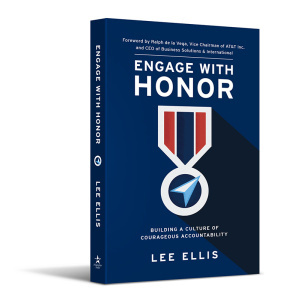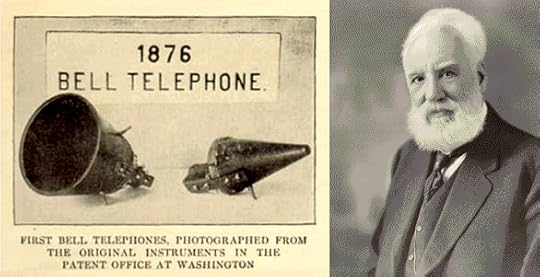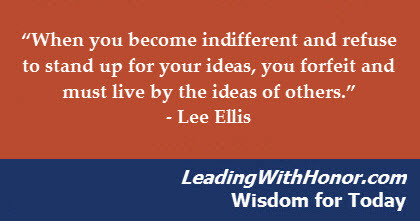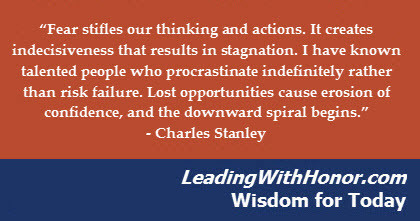Lee Ellis's Blog, page 260
October 10, 2016
The 4C’s to Restore Honor in Today’s Election Cycle
One of Lee’s main objectives in the next few weeks is to help restore honor in today’s election cycle. What can you do? He offer 4C’s in Home Business Magazine.
Please check them out and please share your comments here – thank you


October 9, 2016
On This Day in Leadership History for October 9, 2016
On this day in leadership history in 1876, Alexander Graham Bell and Thomas Watson made their longest telephone call to date. It was a distance of two miles. The leadership lesson? Don’t despise small beginnings—get started where you are and keep innovating.
Alexander Graham Bell – Wikipedia


October 8, 2016
Video Coaching: Develop a Mindset for Collaboration
If you’re not courageously collaborating with your team, you’re missing out on a strategic advantage in making your work goals more attainable. Lee shares his leadership coaching on this topic –
Read the article on this topic, too! And please share your comments in this forum – thank you


October 7, 2016
Leading with Honor Wisdom for Today, October 7, 2016
“When you become indifferent and refuse to stand up for your ideas, you forfeit and must live by the ideas of others.” – Lee Ellis


October 6, 2016
Are You Asking Stupid Questions? Avoid This Pitfall
Are your leaders asking stupid questions? If they are, they will likely get stupid answers when they do get answers, and they will believe the answers. Avoid this pitfall—great advice from Mary Kelly PhD at Productive Leaders –


October 5, 2016
5 Practical Results of Team Collaboration
(EDITOR’S NOTE: Just a reminder that Lee’s newest book, Engage with Honor, was released on September 7th. If you desire to be a strong influence on others during this presidential election season, this very practical “how to” book gives great insight for building the culture that you want as a leader. As Lee says, “When you become indifferent and refuse to stand up for your ideas, you forfeit and must live by the ideas of others.” Please check it out at your favorite retailer, or read more reviews at www.engagewithhonor.com.)
By Lee Ellis
If you have a highly competitive personality, perhaps collaboration is a challenge for you. After all, winning is the primary goal, right? But if you have no one to share your success, it ultimately becomes an exercise in futility. Chapter 8 in my book, Engage with Honor, addresses this topic head-on.
Collaboration in the Camps
In life and death situations of the Vietnam POW camps where leaders were often in isolated cells, collaboration was a natural leadership style (technique). Even the most confident, experienced, results-oriented warriors among us realized that they couldn’t dominate the group or withdraw and operate independently. Instead, they risked added torture and exposure reaching out to others to connect and collaborate. Senior leaders knew that their success depended on a team effort of “courageous collaboration” with their followers—it was essential for survival and success.
Competing at the Expense of Collaboration
Collaboration isn’t easy for everyone. In our early careers, we are often competitively focused on developing our own expertise and competence more than collaborating with our peers. But like the POW camps, today’s environment for success is more dependent on a team effort. With ubiquitous knowledge and rapidly changing technology, leaders are often not the experts. Like the POW leaders, they’re managing things that they have never done.
“Using collaboration is now a required ingredient in building a winning model of accountability and performance.” [Tweet This]
Collaboration can also be a challenge because it requires –
both confidence and humility. Today’s honorable leader must confidently give away power and correct others when needed while humbly listening and learning from them.
balancing concern for results (vision, standards, accountability) with caring for people (valuing others, supporting, encouraging, coaching). And the clincher is that we’re naturally wired to favor one over the other. Balance between these two mindsets must be learned.
Developing a Collaborative Mindset
“The entire concept of courageous collaboration is anchored in the fact that people want to succeed.” [Tweet This]
They want to be a part of something larger than themselves, they want to be valued, and they want to count for something. When the collaborative leader assumes goodwill, treats others with dignity and respect, and believes in them, they will be inspired to respond with their best. You can see that adopting this mindset as part of your leadership strategy requires confidence and courage to get past the fears that would cause many of us to control and dictate more than collaborate. That’s why courage provides the steel backbone of the Courageous Accountability Model.
Practical Benefits of Collaboration
Five proven, important benefits of collaboration are that it –
Facilitates alignment. When individual talents are aligned and working in concert, there’s a unity of effort that brings synergy and astonishing levels of execution. Picture the Thunderbirds or Blue Angels demonstration teams or a perfect performance by the Radio City Rockettes.
Promotes three-dimensional, 360 degree leadership and performance. When leaders collaborate with their peers, it frees their direct reports to collaborate at their peer level, breaking down silos and working more efficiently and effectively.
Gets better results. If you look at high-performing organizations, you’ll find alignment, good communications, and leaders that trust their people to execute the mission.
Builds teamwork and develops people. Collaboration builds trust. The better you know each person, the more effectively you can work with them or lead them. More understanding means more trust which means stronger teams that are growing as they learn from each other.
Helps minimize risks. In the POW camps our covert communications depended on collaboration. While I was the lead communicator in my cell, I was totally dependent on my cellmates and the guys next door to “clear” for me. Their eyes and ears and danger signals made it possible for me to do my job. Likewise, working together as a team reduces risk in every workplace. Think about the operating room in a hospital. If the team of doctors, nurses, and support specialists don’t collaborate, the risk for tragedy and malpractice suits is high.
The Collaboration Payoff
If this mindset of collaborative leadership is new to you or seems hard or a bit scary, let me challenge you to consider the benefits. The payoff for your hard work is going to be better results, higher morale, better engagement and retention, and a bench of next generation leaders who are ready to step in.
Now that you know the benefits, next time we’ll look at Chapter 9 and discuss how to carry out collaborative leadership. What has been your experience? As a leader? As a follower with and without collaborative leadership? Please share your comments here.
LE
Get the Engage with Honor Launch Package for Your Team
 Please consider joining Lee in sharing the Engage with Honor message through buying bulk copies! Order your copies now for free access to these exclusive features:
Please consider joining Lee in sharing the Engage with Honor message through buying bulk copies! Order your copies now for free access to these exclusive features:
ORDER UP TO 9 COPIES AND RECEIVE THIS PACKAGE:
Free Leading with Honor 1-Page Mini Report
Discussion Guide for Groups
6 Coaching Videos by Lee Ellis
10 Video Clips Explaining each chapter
A Case Study on Balancing Results and Relationships
A copy of The Honor Code to Share with Your Team and Colleagues
The Courage Challenge Card – A Tool for Maximum Employee Engagement
Free Monthly Leading with Honor Coaching sent to your inbox
Special Discounts on Leading with Honor Live Training for your team or organization
ORDER 10 OR MORE COPIES AND RECEIVE THIS PACKAGE:
Free Leadership Behavior DNA Assessment (A $125 Value)
All of the other features listed above.
Order on EngageWithHonor.com


October 4, 2016
Leadership Tip to Maintain High Morale
“I’ve never had an airman come back from a deployment raving about the quality of life downrange. They come back and talk to me about the mission. They talk about whether they were valued,” Goldfein said. “Whether they contributed and made a difference. That’s what makes high morale.” – Gen. David L. Goldfein, Chief of Staff, USAF


October 2, 2016
On This Day in Leadership History for October 2, 2016
On this day in leadership history in 1950, the “Peanuts” the comic strip created by Charles M. Schulz, was published for the first time in seven newspapers. What’s the leadership lesson? Have they ever made you feel good? Have you ever learned any important lessons from them? How many times have you shared or remarked about them with others? May our leadership have the same impact where we live and work!
Peanuts – Wikipedia


October 1, 2016
We’re so grateful for endorsements like the ones below for ‘Engage with Honor’
 We’re so grateful for endorsements like the ones below for ‘Engage with Honor’ – doesn’t get much better than this! Thanks for allowing us to share:
We’re so grateful for endorsements like the ones below for ‘Engage with Honor’ – doesn’t get much better than this! Thanks for allowing us to share:
“His courageous accountability model is an excellent guide to learning our way through uncertainty and complexity. It is a must read for generations of leaders to come.”
– LTG James L. Terry, Retired Commanding General, United States Army Central
“I have been searching for a clear way to link servant leadership and accountability. Lee provides a clear path with The Courageous Accountability Model…Thank you Lee for your lessons, life experience, and service.”
– Pat Falotico, CEO, Greenleaf Center for Servant Leadership
Engage with Honor – Buy the Book


September 30, 2016
Leading with Honor Wisdom for Today, September 30, 2016
“Fear stifles our thinking and actions. It creates indecisiveness that results in stagnation. I have known talented people who procrastinate indefinitely rather than risk failure. Lost opportunities cause erosion of confidence, and the downward spiral begins.” – Charles Stanley













